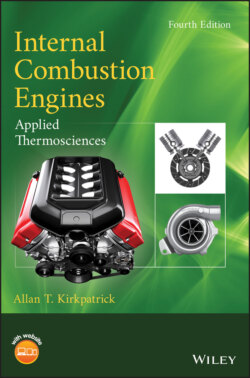Читать книгу Internal Combustion Engines - Allan T. Kirkpatrick - Страница 65
Energy Equation
ОглавлениеWe now develop a simple spark‐ignition finite energy release model by incorporating the Wiebe function equation, Equation (2.71), into the differential energy equation. We assume that the energy release begins with spark ignition at and has a combustion duration during the compression and expansion strokes, and solve for the resulting cylinder pressure as a function of crank angle. The simple model assumes the inlet and exhaust valves are closed at the start of integration at , so it does not account for flow into and out of the combustion chamber.
As shown in the following derivation, the differential form of the energy equation does not have a simple analytical solution due to the finite energy release term. It is integrated numerically, starting at bottom dead center, compressing to top dead center, and then expanding back to bottom dead center.
The closed‐system differential energy equation (note that work and heat interaction terms are not true differentials) for a small crank angle change, , is
(2.73)
since , and
(2.74)
Assuming ideal gas behavior,
(2.75)
which in differential form is
(2.76)
The energy equation is therefore
(2.77)
differentiating with respect to crank angle, and introducing ,
(2.78)
Solving for the pressure, ,
(2.79)
In practice, it is convenient to normalize the equation with the pressure and volume at bottom dead center
(2.80)
in which case we obtain
(2.81)
The differential equation for the work is
(2.82)
where
(2.83)
In order to integrate Equations (2.81) and (2.82), an equation for the cylinder volume as a function of crank angle is needed. By reference to Chapter 1, the dimensionless cylinder volume for is
(2.84)
upon differentiation,
(2.85)
Equations (2.81) and (2.82) are linear first‐order differential equations of the form , and are easily solved by numerical integration. Solution yields and , which once determined, allows computation of the net work of the cycle, the thermal efficiency, and the indicated mean effective pressure. Note that in this analysis, we have neglected heat and mass transfer losses, and will consider them in the next section.
The thermal efficiency is computed directly from its definition
(2.86)
The imep is then computed using Equation (2.87)
(2.87)
For the portions of the compression and expansion strokes before ignition and after combustion, i.e., where and , the energy release term , allowing straightforward integration of the energy equation and recovery of the isentropic pressure‐volume relation:
(2.88)
(2.89)
(2.90)
The differential energy equation, Equation (2.79), is also used to compute energy release curves from experimental measurements of the cylinder pressure. This procedure is discussed in detail in Chapter 12. Commercial combustion analysis software is available to perform such analysis in real time during an engines experiment.
The computer program FiniteHeatRelease.m is listed in the Appendix, and can be used to compare the performance of two different engines with different combustion and geometric parameters. The program computes gas cycle performance by numerically integrating Equation (2.79) for the pressure as a function of crank angle. The integration starts at bottom dead center = −180), with initial inlet conditions , the gas molecular mass, , and specific heat ratio, , given. The integration proceeds degree by degree to top dead center = 0) and back to bottom dead center. Once the pressure is computed as a function of crank angle, the net work, thermal efficiency, and imep are also computed. The use of the program is detailed in the following example.
